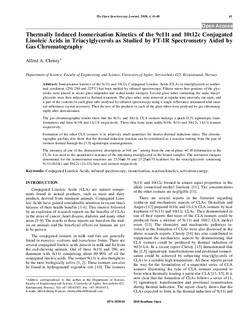Thermally Induced Isomerisation Kinetics of the 9c11t and 10t12c Conjugated Linoleic Acids in Triacylglycerols as Studied by FT-IR Spectrometry Aided by Gas Chromatography
Original version
Christy, A. A. (2010). Thermally Induced Isomerisation Kinetics of the 9c11t and 10t12c Conjugated Linoleic Acids in Triacylglycerols as Studied by FT-IR Spectrometry Aided by Gas Chromatography. The Open Spectroscopy Journal, 4, 41-48. doi: 10.2174/1874383801004010041Abstract
Isomerisation kinetics of the 9c11t and 10t12c Conjugated Linoleic Acids (CLA) in triaclglycerols at isothermal
conditions (250, 280 and 325oC) has been studied by infrared spectroscopy. Fifteen micro liter portions of the glycerides
were placed in micro glass ampoules and sealed under nitrogen. Several glass tubes containing the same triacylglycerols
were then subjected to thermal treatment. The glass tubes were removed at regular time intervals, cut open, and
a part of the contents in each glass tube analysed by infrared spectroscopy using a single reflectance attenuated total internal
reflectance crystal accessory. Then the rest of the products in each of the glass tubes were analysed by gas chromatography
after derivatisation.
The gas chromatographic results show that the 9t11c and 10t12c CLA isomers undergo a quick [1,5] sigmatropic transformations
and form 8c10t and 11c13t respectively. These then form more stable 8t10t, 9t11t and 10t12t, 11t13t isomers
respectively.
Formation of the other CLA isomers is in relatively small quantities for shorter thermal induction times. The chromatographic
profiles also show that the thermal induction reaction can be considered as a reaction starting from the pair of
isomers formed through the [1.5] sigmatropic rearrangements.
The intensity of one of the characteristic absorptions at 944 cm-1 arising from the out-of-plane =C-H deformation in the
CLAs was used as the quantitative measure of the remaining triaclglycerol in the heated samples. The activation energies
determined for the isomerisation reactions are 25.500.30 and 25.250.70 kcal/mol for the triacylglycerols containing
9c11t (8t10c) and 10t12c (11c13t) fatty acid isomers respectively.
Description
Published version of an article from the journal:The Open Spectroscopy Journa. Also available from the publisher:http://dx.doi.org/10.2174/1874383801004010041. Open Access
